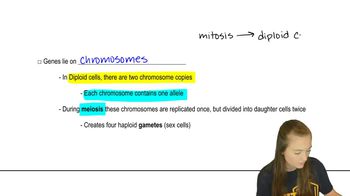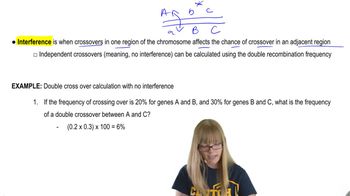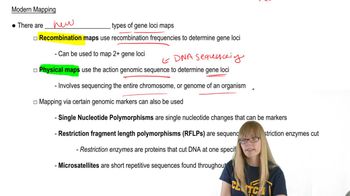Table of contents
- 1. Introduction to Genetics51m
- 2. Mendel's Laws of Inheritance3h 37m
- 3. Extensions to Mendelian Inheritance2h 41m
- 4. Genetic Mapping and Linkage2h 28m
- 5. Genetics of Bacteria and Viruses1h 21m
- 6. Chromosomal Variation1h 48m
- 7. DNA and Chromosome Structure56m
- 8. DNA Replication1h 10m
- 9. Mitosis and Meiosis1h 34m
- 10. Transcription1h 0m
- 11. Translation58m
- 12. Gene Regulation in Prokaryotes1h 19m
- 13. Gene Regulation in Eukaryotes44m
- 14. Genetic Control of Development44m
- 15. Genomes and Genomics1h 50m
- 16. Transposable Elements47m
- 17. Mutation, Repair, and Recombination1h 6m
- 18. Molecular Genetic Tools19m
- 19. Cancer Genetics29m
- 20. Quantitative Genetics1h 26m
- 21. Population Genetics50m
- 22. Evolutionary Genetics29m
4. Genetic Mapping and Linkage
Mapping Genes
Problem 29e
Textbook Question
Textbook QuestionA female of genotype
a b c
+ + +
produces 100 meiotic tetrads. Of these, 68 show no crossover events. Of the remaining 32, 20 show a crossover between a and b, 10 show a crossover between b and c, and 2 show a double crossover between a and b and between b and c. Of the 400 gametes produced, how many of each of the 8 different genotypes will be produced? Assuming the order a–b–c and the allele arrangement previously shown, what is the map distance between these loci?
 Verified Solution
Verified SolutionThis video solution was recommended by our tutors as helpful for the problem above
Video duration:
1mPlay a video:
Was this helpful?
Key Concepts
Here are the essential concepts you must grasp in order to answer the question correctly.
Meiotic Tetrads
Meiotic tetrads are structures formed during meiosis, consisting of four chromatids from two homologous chromosomes. They are crucial for understanding genetic recombination, as they allow for the exchange of genetic material between homologous chromosomes during crossover events. The number of tetrads and the types of crossover events that occur can significantly influence the genetic variation in the resulting gametes.
Recommended video:
Guided course

Diploid Genetics
Crossover Events
Crossover events occur during meiosis when homologous chromosomes exchange segments of genetic material. This process increases genetic diversity by producing new allele combinations in gametes. The question specifies different types of crossover events, including single and double crossovers, which affect the frequency of various genotypes in the offspring and are essential for calculating genetic map distances.
Recommended video:
Guided course

Multiple Cross Overs and Interference
Genetic Map Distance
Genetic map distance is a measure of the relative distance between genes on a chromosome, typically expressed in centimorgans (cM). It is calculated based on the frequency of recombination events between genes; a higher frequency indicates a greater distance. Understanding how to calculate map distances is vital for interpreting genetic linkage and predicting the inheritance patterns of traits.
Recommended video:
Guided course

Mapping Genes
Related Videos
Related Practice




